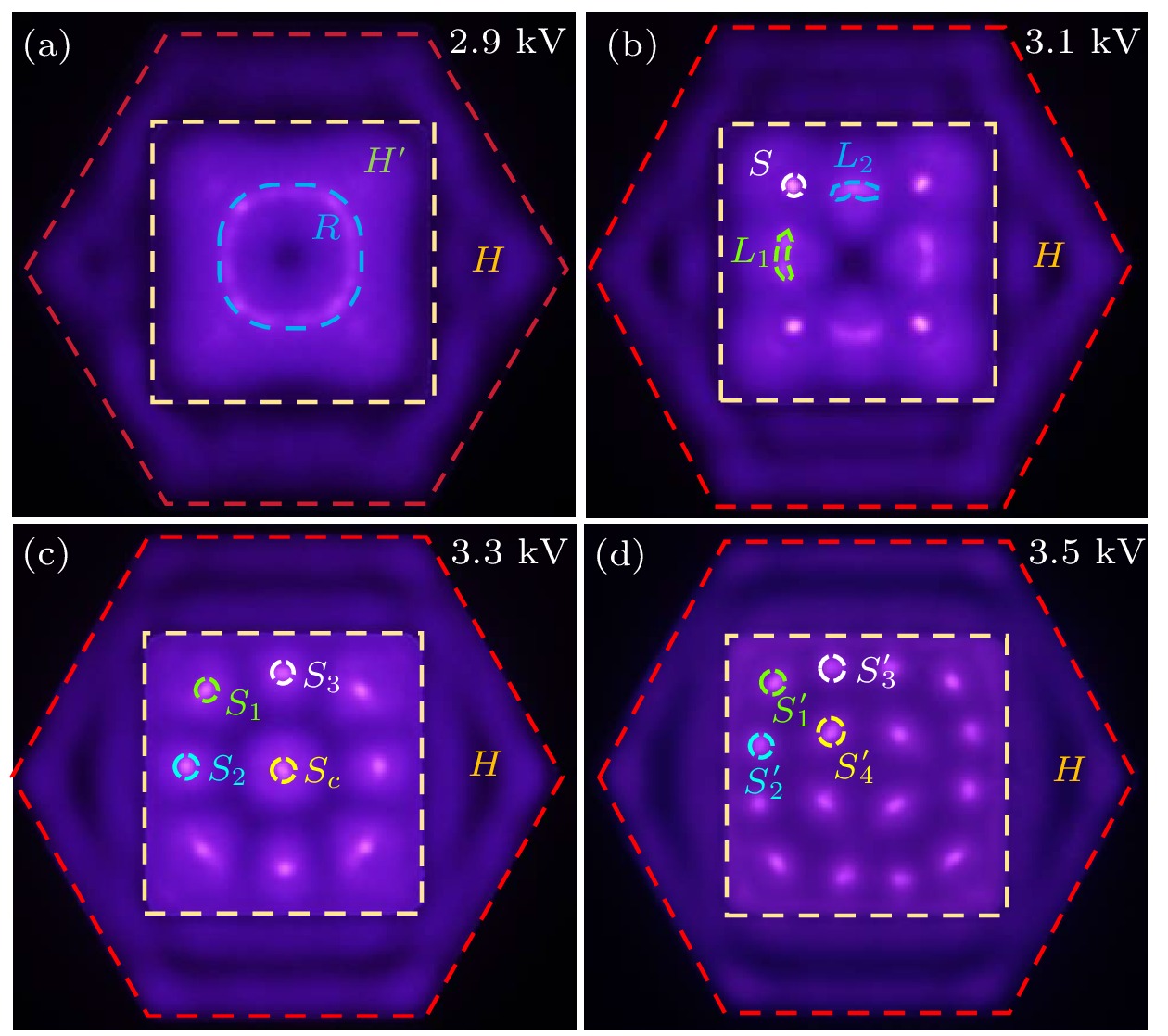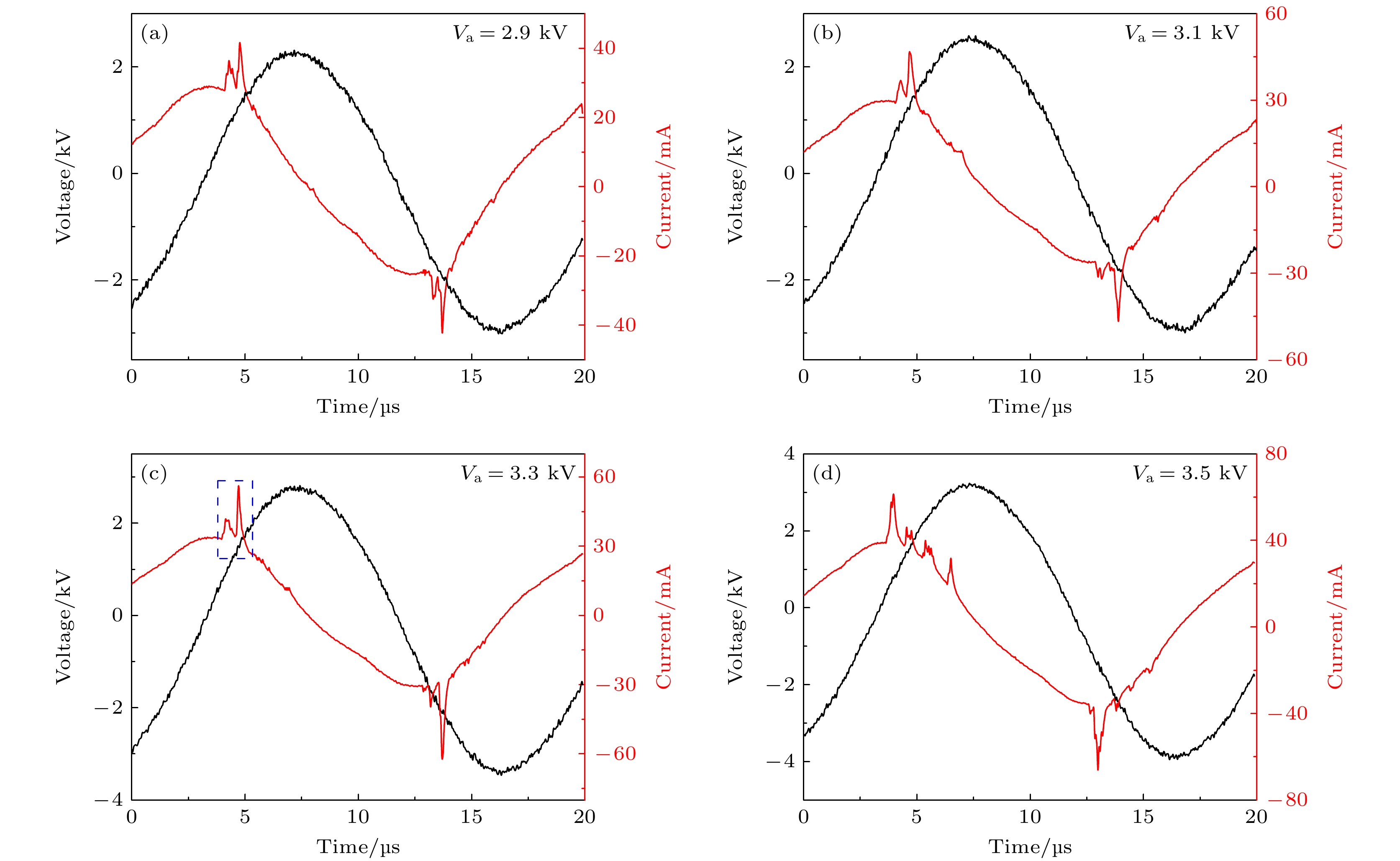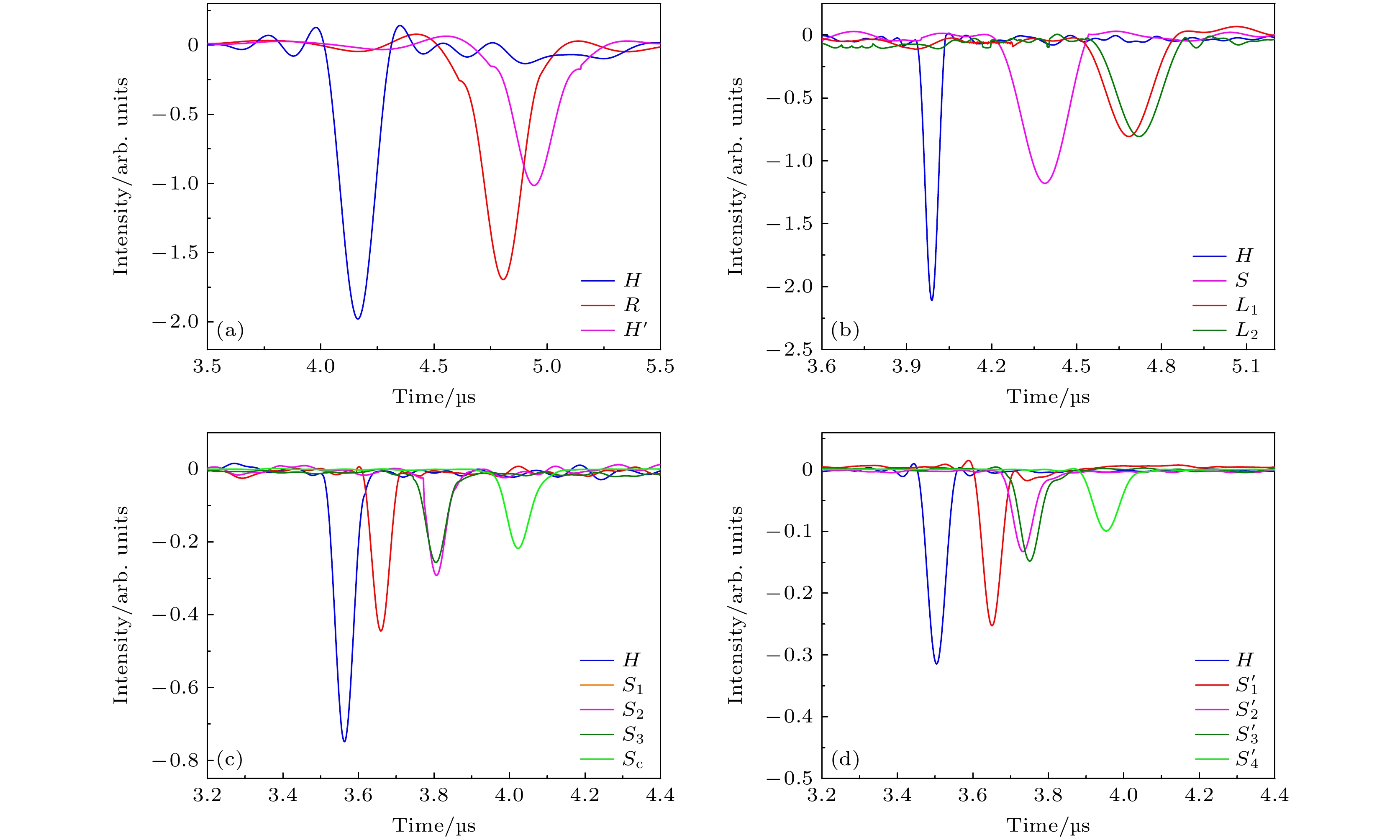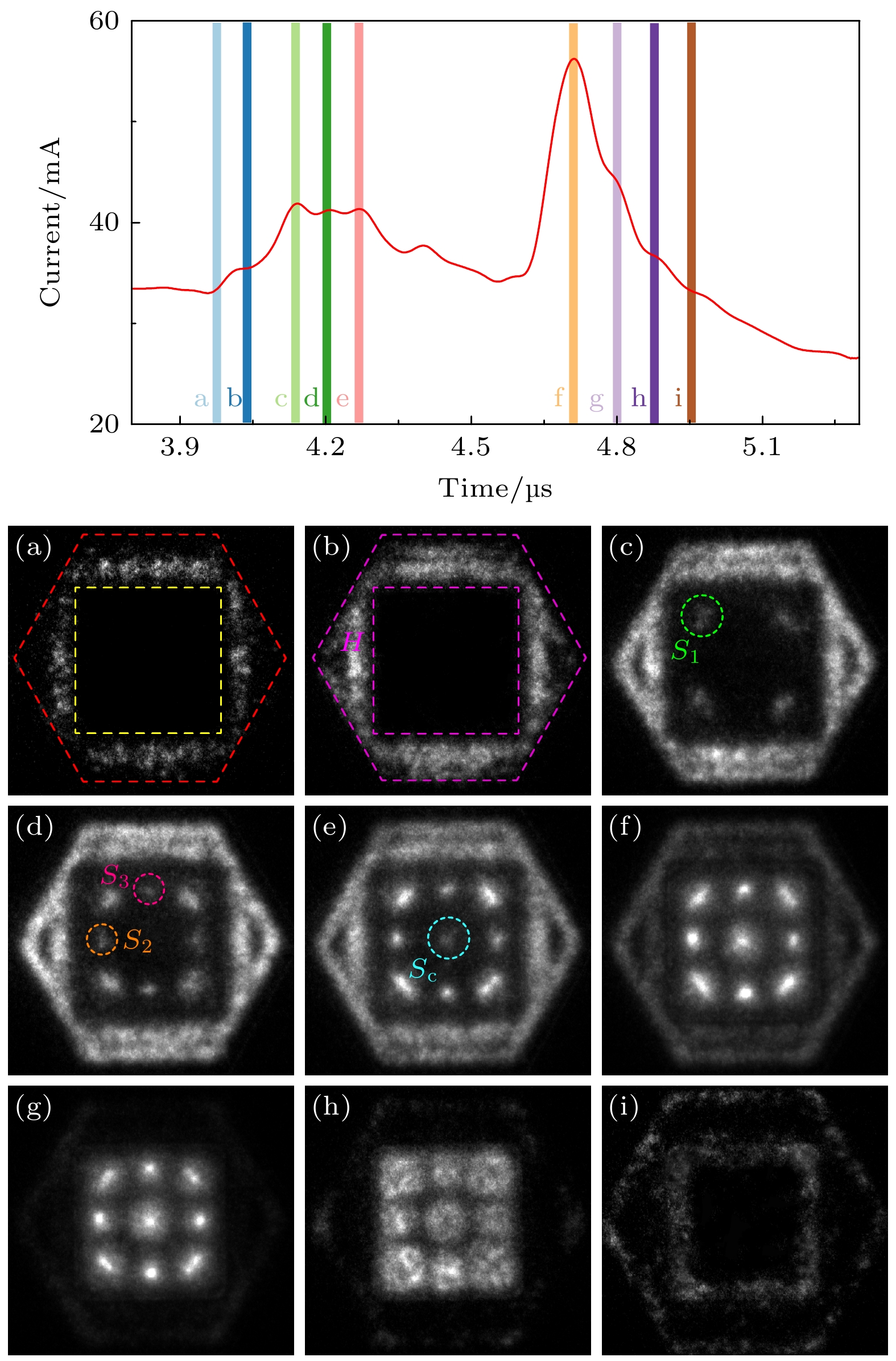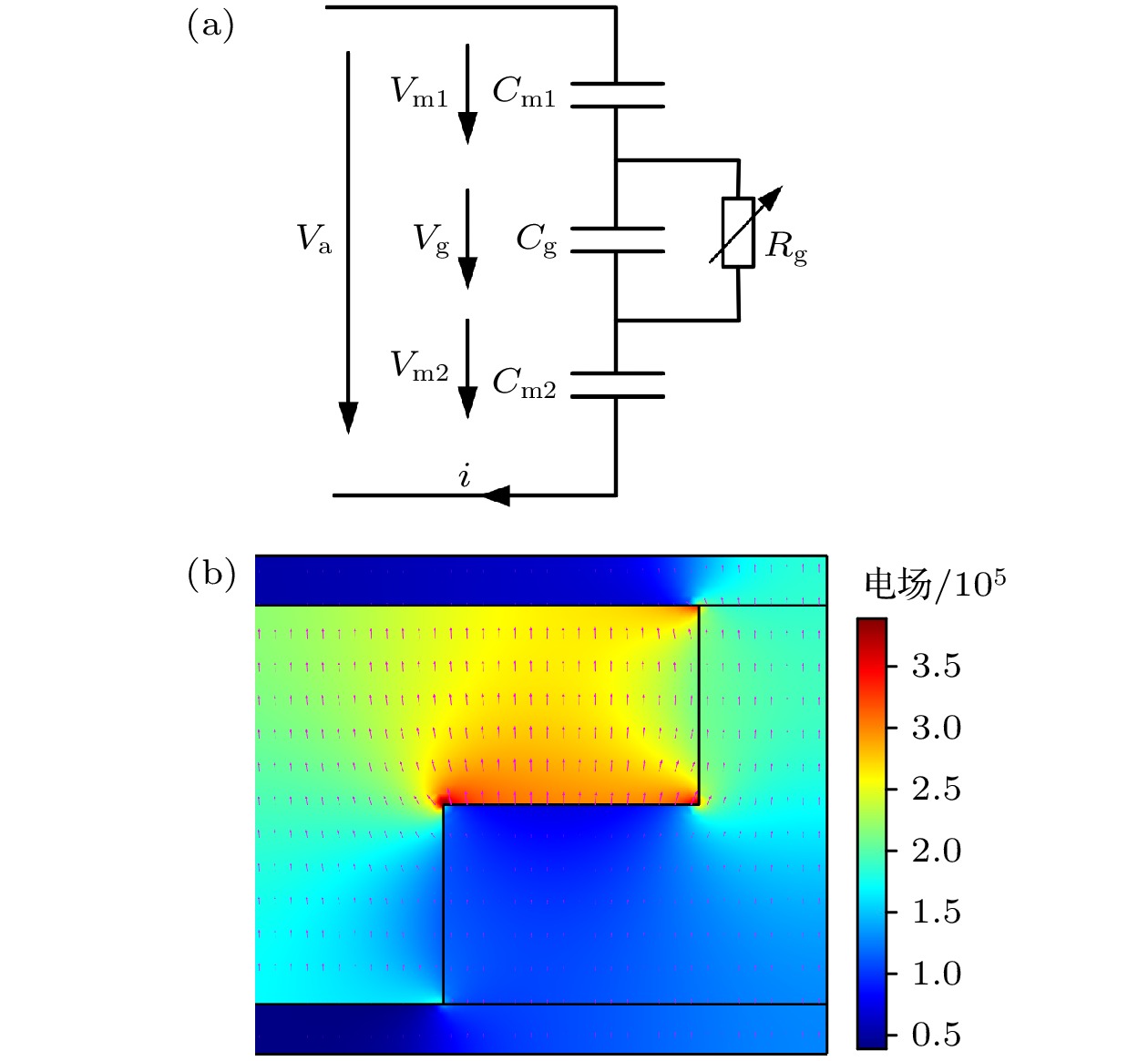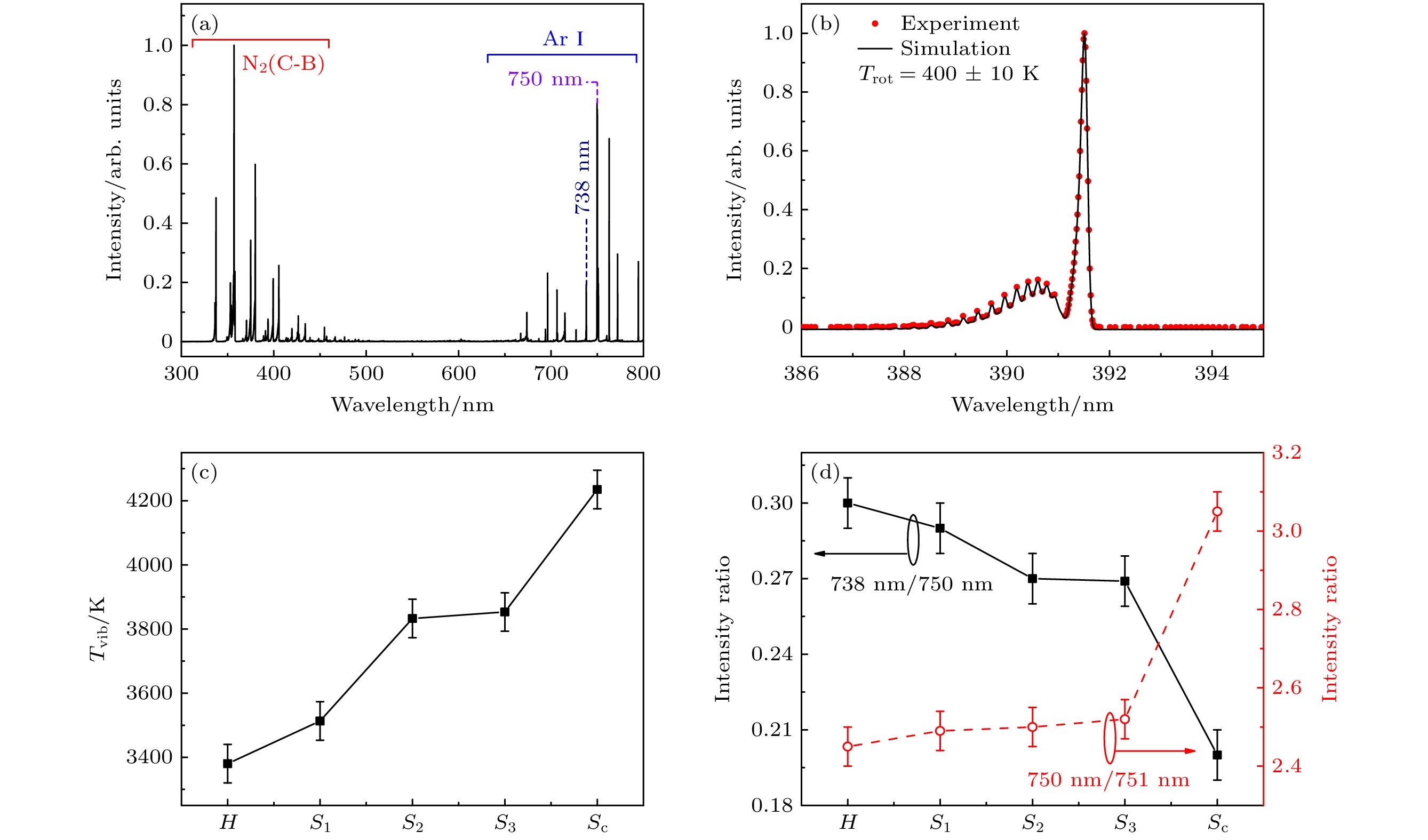-
斑图放电是介质阻挡放电的重要模式之一, 在众多领域具有广泛的应用前景. 本工作在氩气/空气混合气体介质阻挡放电系统中, 采用正六边形和方形组成的双气隙边界, 通过改变实验参数, 获得了多个全新的复杂斑图. 利用光学与电学手段研究了其放电特性及其时间相关性. 结果表明放电斑图在每半个电压周期内均有多次放电并在时间上具有相关性. 利用增强型电荷耦合设备拍摄了方形点阵斑图时间分辨的放电图像, 发现半个电压周期内的多次放电其实是斑图在径向上从外向内逐渐点亮的过程, 理论分析了该斑图的形成机理. 采集了方形点阵斑图的发射光谱, 通过线比法和玻尔兹曼拟合法探究了方形点阵斑图的电子密度、电子温度、分子振动温度、分子转动温度的变化. 结果显示电子密度沿着径向方向从外到内逐渐减小, 电子温度与分子振动温度沿着径向方向从外到内逐渐增加, 分子转动温度几乎不变.Pattern discharge is a common mode in dielectric barrier discharge (DBD) and has broad application prospects in various industrial fields, such as material surface treatment, environmental monitoring, and biomedical applications. In this work, a mixed gas of 75% argon and 25% air is used to generate a pattern discharge. A double-gap boundary composed of hexagonal configuration and square configuration is employed, and the gas pressure is fixed at 20 kPa. By varying the applied voltage amplitude, single-ring pattern, square-point-line pattern, square lattice pattern, and annular-lattice pattern are obtained for the first time. The discharge characteristics and their temporal correlation are studied using both optical method and electrical method. The results show that the discharge patterns exhibit multiple discharges in each half of the voltage cycle, and these discharges are temporally correlated with each other. Time-resolved discharge images of the square lattice pattern are captured using an enhanced charge-coupled device (ICCD). The experimental results reveal that multiple discharges in a half-voltage cycle correspond to the ignition process of the pattern in the radial direction from the outside to the inside. The morphology of the square lattice pattern observed by the naked eye is actually the result of the temporal superposition of luminescence from points at different positions in the evolution process. The formation mechanism of this pattern is analyzed through electric field simulations and theoretical calculations. Plasma parameters are diagnosed by collecting the emission spectrum of the square dot-lattice pattern. The results show that the electron density gradually decreases radially from the outer region to the inner region, while the electron temperature and molecular vibrational temperature increase radially from the outer region to the inner region, and the molecular rotational temperature remains almost unchanged. The temporal evolution of the square lattice pattern is shown in the following figures, where the current waveform marks the timing of each frame of ICCD imaging for the complete square lattice pattern.
[1] Zhang J, Tang W W, Wang Y H, Wang D Z 2023 Plasma Sources Sci. Technol. 32 055005
 Google Scholar
Google Scholar
[2] Li J Y, Zhou D S, Rebrov E, Tang X, Kim M 2024 J. Phys. D: Appl. Phys. 57 395201
 Google Scholar
Google Scholar
[3] Fang J L, Zhang Y R, Lu C Z, Gu L L, Xu S F, Guo Y, Shi J J 2024 Chin. Phys. B 33 015201
 Google Scholar
Google Scholar
[4] Guan H L, Chen X R, Jiang T, Du H, Paramane A, Zhou H 2020 Chin. Phys. B 29 075204
 Google Scholar
Google Scholar
[5] Li X C, Liu R J, Li X N, Gao K, Wu J C, Gong D D, Jia P Y 2019 Phys. Plasmas 26 023510
 Google Scholar
Google Scholar
[6] Remy A, Geyter N D, Reniers F 2023 Plasma Process. Polym. 20 2200201
 Google Scholar
Google Scholar
[7] Hosseini H 2023 RSC Adv. 13 28211
 Google Scholar
Google Scholar
[8] Li Y W, Yuan H, Zhou X F, Liang J P, Liu Y Y, Chang D L, Yang, D Z 2022 Catalysts 12 203
 Google Scholar
Google Scholar
[9] Song H, Dang Y M, Ki S H, Park S, Ha J H 2024 LWT 207 116637
 Google Scholar
Google Scholar
[10] Domonkos M, Tichá P, Trejbal J, Demo P 2021 Appl. Sci. 11 4809
 Google Scholar
Google Scholar
[11] Massines F, Sarra-Bournet C, Fanelli F, Naudé N, Gherardi N 2012 Plasma Process. Polym. 9 1041
 Google Scholar
Google Scholar
[12] Akishev Y, Alekseeva T, Karalnik V, Petryakov A 2022 Plasma Sources Sci. Technol. 31 084001
 Google Scholar
Google Scholar
[13] Tschiersch R, Nemschokmichal S, Bogaczyk M, Meichsner J 2017 J. Phys. D: Appl. Phys. 50 415206
 Google Scholar
Google Scholar
[14] 刘凯, 方泽, 戴栋 2023 72 135201
 Google Scholar
Google Scholar
Liu K, Fang Z, Dai D 2023 Acta Phys. Sin. 72 135201
 Google Scholar
Google Scholar
[15] Ran J X, Zhang X X, Zhang Y, et al. 2023 Plasma Sci. Technol. 25 055403
 Google Scholar
Google Scholar
[16] Lu X P, Fang Z, Dai D, Shao T, Liu F, Zhang C, Liu D W, Nie L L, Jiang C Q 2023 High Volt. 8 1132
 Google Scholar
Google Scholar
[17] Brandenburg R 2018 Plasma Sources Sci. Technol. 26 053001
[18] Wang Y Y, Yan H J, Li T, Bai X D, Wang X, Song J, Zhang Q Z 2023 AIP Adv. 13 085327
 Google Scholar
Google Scholar
[19] 万海容, 郝艳捧, 房强, 苏恒炜, 阳林, 李立浧 2020 69 145203
 Google Scholar
Google Scholar
Wang H R, Hao Y P, Fang Q, Su H W, Yang L, Li L C 2020 Acta Phys. Sin. 69 145203
 Google Scholar
Google Scholar
[20] Wu K Y, Wu J C, Jia B Y, Ren C H, Kang P C, Jia P Y, Li X C 2020 Phys. Plasmas 27 082308
 Google Scholar
Google Scholar
[21] Ouyang J T, Li B, He F, Dai D 2018 Plasma Sci. Technol 20 103002
 Google Scholar
Google Scholar
[22] Hao Y P, Han Y Y, Huang Z M, Yang L, Dai D, Li L C 2018 Phys. Plasmas 25 013516
 Google Scholar
Google Scholar
[23] Li X C, Liu R, Jia P Y, Wu K Y, Ren C H, Yin Z Q 2018 Phys. Plasmas 25 013512
 Google Scholar
Google Scholar
[24] Li Z Y, Jin S H, Xian Y B, Nie L L, Liu D W, Lu X P 2021 Plasma Sources Sci. Technol. 30 065026
 Google Scholar
Google Scholar
[25] Zhang Y H, Ning W J, Dai D, Wang Q 2019 Plasma Sources Sci. Technol. 28 075003
 Google Scholar
Google Scholar
[26] Zhang J H, Pan Y Y, Feng J Y, He Y N, Chu J H, Dong L F 2023 Plasma Sci. Technol. 25 025406
 Google Scholar
Google Scholar
[27] Duan X X, Ouyang J T, Zhao X F, He F 2009 Phys. Rev. E 80 016202
 Google Scholar
Google Scholar
[28] Wang X, Yan H J, Wang Y Y, Yu S Q, Li T, Song J 2023 J. Phys. D: Appl. Phys. 56 105201
 Google Scholar
Google Scholar
[29] Mokrov M S, Raizer Y P 2018 Plasma Sources Sci. Technol 27 065008
 Google Scholar
Google Scholar
[30] Hao F, Dong L F, Du T, et al. 2018 Phys. Plasmas 25 033510
 Google Scholar
Google Scholar
[31] Han R, Dong L F, Huang J Y, Sun H Y, Liu B B, Mi Y L 2019 Chin. Phys. B 28 075204
 Google Scholar
Google Scholar
[32] Sun H Y, Dong L F, Liu F C, Mi Y L, Han R, Huang J Y, Liu B B, Hao F, Pan Y Y 2018 Phys. Plasmas 25 113507
 Google Scholar
Google Scholar
[33] Wei L Y, Dong L F, Fan W L, et al. 2018 Sci. Rep. 8 3835
 Google Scholar
Google Scholar
[34] Feng J Y, Dong L F, Wei L Y, Fan W L, Li C X, Pan Y Y 2016 Phys. Plasmas 23 093502
 Google Scholar
Google Scholar
[35] Pan Y Y, Li Y H, Dou Y Y, Fu G S, Dong L F 2022 Phys. Plasmas 29 053502
 Google Scholar
Google Scholar
[36] Liu F C, Liu Y N, Liu Q, et al. 2022 Plasma Sources Sci. Technol 31 025015
 Google Scholar
Google Scholar
[37] Li C X, Dong L F, Feng J Y, Huang Y P 2019 Phys. Plasmas 26 023505
 Google Scholar
Google Scholar
[38] Pan Y Y, Feng J Y, Li C X, Dong L F 2022 Plasma Sci. Technol. 24 115401
 Google Scholar
Google Scholar
[39] Li Y H, Pan Y Y, Tian M, Wang Y, He Y N, Zhang J H, Chu J H, Dong L F 2023 Phys. Plasmas 30 033502
 Google Scholar
Google Scholar
[40] Liu S H, Neiger M 2003 J. Phys. D: Appl. Phys. 36 3144
 Google Scholar
Google Scholar
[41] Bruggeman P J, Sadeghi N, Schram D C, Linss V 2014 Plasma Sources Sci. Technol. 23 023001
 Google Scholar
Google Scholar
[42] Yang F X, Mu Z X, Zhang J L 2016 Plasma Sci. Technol. 18 79
 Google Scholar
Google Scholar
[43] Zhu X M, Pu Y K 2008 Plasma Sources Sci. Technol. 17 024002
 Google Scholar
Google Scholar
-
图 7 (a) 300—800 nm放电的发射光谱; (b) $ {\text{N}}_{2}^{+} $(B-X)转动谱带拟合结果; (c)方形点阵斑图不同位置处的Tvib; (d)方形点阵斑图不同位置处的Te和ne
Fig. 7. (a) 300–800 nm optical emission spectrum from the discharge; (b) fitting result of rotational bands of the $ {\text{N}}_{2}^{+} $(B-X); (c) Tvib at different positions in the square lattice pattern; (d) Te and ne at different positions in square lattice pattern.
-
[1] Zhang J, Tang W W, Wang Y H, Wang D Z 2023 Plasma Sources Sci. Technol. 32 055005
 Google Scholar
Google Scholar
[2] Li J Y, Zhou D S, Rebrov E, Tang X, Kim M 2024 J. Phys. D: Appl. Phys. 57 395201
 Google Scholar
Google Scholar
[3] Fang J L, Zhang Y R, Lu C Z, Gu L L, Xu S F, Guo Y, Shi J J 2024 Chin. Phys. B 33 015201
 Google Scholar
Google Scholar
[4] Guan H L, Chen X R, Jiang T, Du H, Paramane A, Zhou H 2020 Chin. Phys. B 29 075204
 Google Scholar
Google Scholar
[5] Li X C, Liu R J, Li X N, Gao K, Wu J C, Gong D D, Jia P Y 2019 Phys. Plasmas 26 023510
 Google Scholar
Google Scholar
[6] Remy A, Geyter N D, Reniers F 2023 Plasma Process. Polym. 20 2200201
 Google Scholar
Google Scholar
[7] Hosseini H 2023 RSC Adv. 13 28211
 Google Scholar
Google Scholar
[8] Li Y W, Yuan H, Zhou X F, Liang J P, Liu Y Y, Chang D L, Yang, D Z 2022 Catalysts 12 203
 Google Scholar
Google Scholar
[9] Song H, Dang Y M, Ki S H, Park S, Ha J H 2024 LWT 207 116637
 Google Scholar
Google Scholar
[10] Domonkos M, Tichá P, Trejbal J, Demo P 2021 Appl. Sci. 11 4809
 Google Scholar
Google Scholar
[11] Massines F, Sarra-Bournet C, Fanelli F, Naudé N, Gherardi N 2012 Plasma Process. Polym. 9 1041
 Google Scholar
Google Scholar
[12] Akishev Y, Alekseeva T, Karalnik V, Petryakov A 2022 Plasma Sources Sci. Technol. 31 084001
 Google Scholar
Google Scholar
[13] Tschiersch R, Nemschokmichal S, Bogaczyk M, Meichsner J 2017 J. Phys. D: Appl. Phys. 50 415206
 Google Scholar
Google Scholar
[14] 刘凯, 方泽, 戴栋 2023 72 135201
 Google Scholar
Google Scholar
Liu K, Fang Z, Dai D 2023 Acta Phys. Sin. 72 135201
 Google Scholar
Google Scholar
[15] Ran J X, Zhang X X, Zhang Y, et al. 2023 Plasma Sci. Technol. 25 055403
 Google Scholar
Google Scholar
[16] Lu X P, Fang Z, Dai D, Shao T, Liu F, Zhang C, Liu D W, Nie L L, Jiang C Q 2023 High Volt. 8 1132
 Google Scholar
Google Scholar
[17] Brandenburg R 2018 Plasma Sources Sci. Technol. 26 053001
[18] Wang Y Y, Yan H J, Li T, Bai X D, Wang X, Song J, Zhang Q Z 2023 AIP Adv. 13 085327
 Google Scholar
Google Scholar
[19] 万海容, 郝艳捧, 房强, 苏恒炜, 阳林, 李立浧 2020 69 145203
 Google Scholar
Google Scholar
Wang H R, Hao Y P, Fang Q, Su H W, Yang L, Li L C 2020 Acta Phys. Sin. 69 145203
 Google Scholar
Google Scholar
[20] Wu K Y, Wu J C, Jia B Y, Ren C H, Kang P C, Jia P Y, Li X C 2020 Phys. Plasmas 27 082308
 Google Scholar
Google Scholar
[21] Ouyang J T, Li B, He F, Dai D 2018 Plasma Sci. Technol 20 103002
 Google Scholar
Google Scholar
[22] Hao Y P, Han Y Y, Huang Z M, Yang L, Dai D, Li L C 2018 Phys. Plasmas 25 013516
 Google Scholar
Google Scholar
[23] Li X C, Liu R, Jia P Y, Wu K Y, Ren C H, Yin Z Q 2018 Phys. Plasmas 25 013512
 Google Scholar
Google Scholar
[24] Li Z Y, Jin S H, Xian Y B, Nie L L, Liu D W, Lu X P 2021 Plasma Sources Sci. Technol. 30 065026
 Google Scholar
Google Scholar
[25] Zhang Y H, Ning W J, Dai D, Wang Q 2019 Plasma Sources Sci. Technol. 28 075003
 Google Scholar
Google Scholar
[26] Zhang J H, Pan Y Y, Feng J Y, He Y N, Chu J H, Dong L F 2023 Plasma Sci. Technol. 25 025406
 Google Scholar
Google Scholar
[27] Duan X X, Ouyang J T, Zhao X F, He F 2009 Phys. Rev. E 80 016202
 Google Scholar
Google Scholar
[28] Wang X, Yan H J, Wang Y Y, Yu S Q, Li T, Song J 2023 J. Phys. D: Appl. Phys. 56 105201
 Google Scholar
Google Scholar
[29] Mokrov M S, Raizer Y P 2018 Plasma Sources Sci. Technol 27 065008
 Google Scholar
Google Scholar
[30] Hao F, Dong L F, Du T, et al. 2018 Phys. Plasmas 25 033510
 Google Scholar
Google Scholar
[31] Han R, Dong L F, Huang J Y, Sun H Y, Liu B B, Mi Y L 2019 Chin. Phys. B 28 075204
 Google Scholar
Google Scholar
[32] Sun H Y, Dong L F, Liu F C, Mi Y L, Han R, Huang J Y, Liu B B, Hao F, Pan Y Y 2018 Phys. Plasmas 25 113507
 Google Scholar
Google Scholar
[33] Wei L Y, Dong L F, Fan W L, et al. 2018 Sci. Rep. 8 3835
 Google Scholar
Google Scholar
[34] Feng J Y, Dong L F, Wei L Y, Fan W L, Li C X, Pan Y Y 2016 Phys. Plasmas 23 093502
 Google Scholar
Google Scholar
[35] Pan Y Y, Li Y H, Dou Y Y, Fu G S, Dong L F 2022 Phys. Plasmas 29 053502
 Google Scholar
Google Scholar
[36] Liu F C, Liu Y N, Liu Q, et al. 2022 Plasma Sources Sci. Technol 31 025015
 Google Scholar
Google Scholar
[37] Li C X, Dong L F, Feng J Y, Huang Y P 2019 Phys. Plasmas 26 023505
 Google Scholar
Google Scholar
[38] Pan Y Y, Feng J Y, Li C X, Dong L F 2022 Plasma Sci. Technol. 24 115401
 Google Scholar
Google Scholar
[39] Li Y H, Pan Y Y, Tian M, Wang Y, He Y N, Zhang J H, Chu J H, Dong L F 2023 Phys. Plasmas 30 033502
 Google Scholar
Google Scholar
[40] Liu S H, Neiger M 2003 J. Phys. D: Appl. Phys. 36 3144
 Google Scholar
Google Scholar
[41] Bruggeman P J, Sadeghi N, Schram D C, Linss V 2014 Plasma Sources Sci. Technol. 23 023001
 Google Scholar
Google Scholar
[42] Yang F X, Mu Z X, Zhang J L 2016 Plasma Sci. Technol. 18 79
 Google Scholar
Google Scholar
[43] Zhu X M, Pu Y K 2008 Plasma Sources Sci. Technol. 17 024002
 Google Scholar
Google Scholar
计量
- 文章访问数: 551
- PDF下载量: 18
- 被引次数: 0















 下载:
下载:
